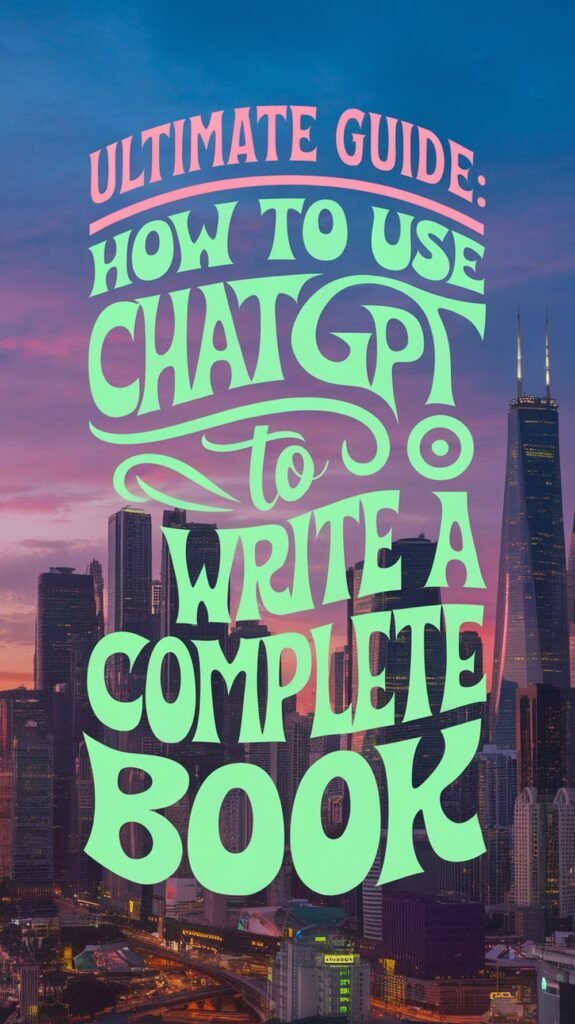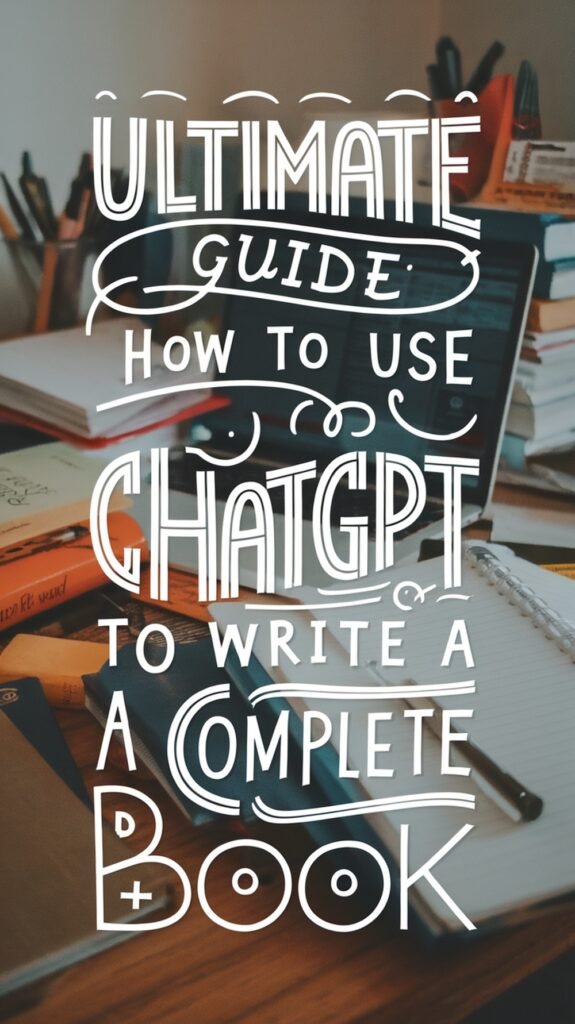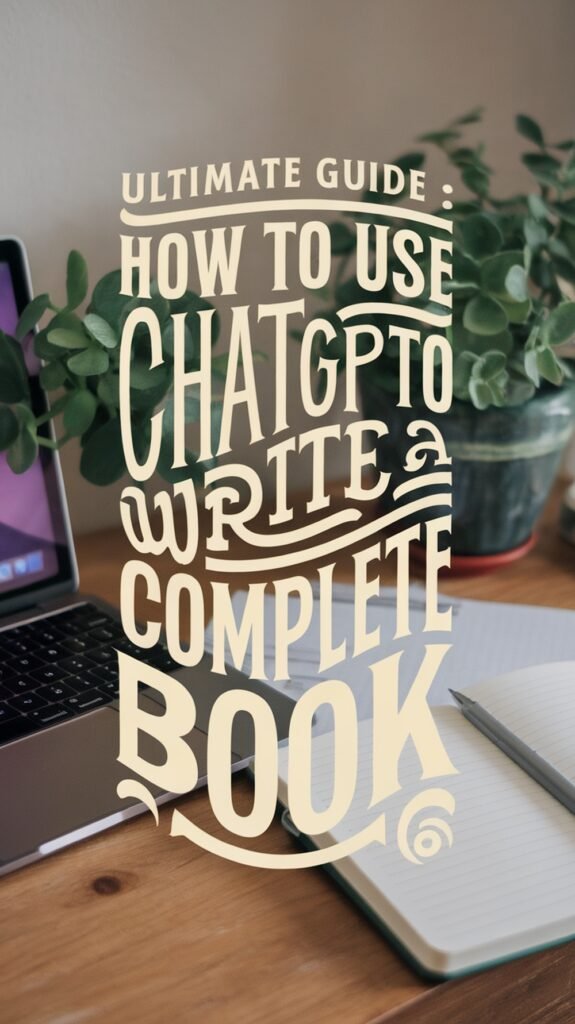
📘 Ultimate Guide: How to Use ChatGPT to Write a Complete Book (Step-by-Step with Details)
Writing a book can feel overwhelming—but with ChatGPT as your creative co-pilot, it becomes a structured, efficient, and even enjoyable journey. This step-by-step guide breaks down exactly how to go from a blank page to a full manuscript.
✅ Step 1: Define Your Book’s Purpose and Target Audience
Before writing anything, clarify:
- Topic/Niche: Is it a how-to, self-help, personal story, or fiction? Example: “Productivity hacks for busy parents” or “A sci-fi thriller set in a Mars colony.”
- Audience: Who are you speaking to? Are they beginners, professionals, fans of a genre, or hobbyists?
- Transformation or Outcome: What will your reader gain or experience after reading your book? Knowledge, inspiration, entertainment?
Prompt ChatGPT:
“I want to write a [nonfiction/fiction] book titled ‘[Title]’. It’s about [Topic] for [Audience]. By the end, readers should be able to [Outcome]. Can you help me outline it?”
✅ Step 2: Generate a Book-Worthy Outline
Ask ChatGPT to break your book idea into 8–15 chapters.
Prompt:
“Based on this topic, create a detailed chapter-by-chapter outline for a [genre/topic] book. Include a short paragraph summary for each chapter.”
📌 Pro Tip: For longer books (50k+ words), aim for 12–15 chapters. Short guides or ebooks can work with 6–8 chapters.
Example Output:
- Chapter 1: The Morning Myth
Why traditional morning routines don’t work for everyone, and how to create a rhythm that suits your lifestyle. - Chapter 2: The 80/20 Productivity Rule
Focus on tasks that drive 80% of results using real-life case studies.
✅ Step 3: Break Each Chapter into Subsections
To make each chapter feel manageable, turn it into 4–6 key subsections.
Prompt:
“Expand Chapter [X] into detailed subsections. Include descriptions and key points for each section.”
This gives you a mini-outline for each chapter—ideal for writing in short sprints.
Example for Chapter on Email Marketing:
- Understanding Your Audience
How to define buyer personas that shape your tone and content. - Building a List
List-building tools, opt-ins, and ethical strategies. - Writing High-Conversion Emails
Subject lines, copywriting tips, and A/B testing. - Automation Secrets
Setting up welcome sequences and engagement loops.

✅ Step 4: Draft Full Chapters Using ChatGPT
Now, the magic. Start turning your outlines into full chapters.
Prompt:
“Write a detailed 1,000-word chapter on [Topic/Outline] using a friendly and informative tone. Include examples, step-by-step guidance, and practical tips.”
If it feels too generic:
“Rewrite this chapter with a more conversational tone and add real-world examples and quotes.”
📌 Time-Saving Tip: You can ask ChatGPT to write each section separately, then combine and edit. This prevents overwhelming drafts and gives more control.
✅ Step 5: Revise, Expand, and Polish
Use ChatGPT for editing support, then refine it manually.
Prompt:
“Edit this chapter for flow, clarity, and tone consistency. Make sure it reads like a published book.”
Or:
“Expand this section to include a case study or detailed example.”
Add Personal Touches:
- Insert your own stories
- Add charts, stats, or infographics
- Use humor or emotion to deepen the reader connection
✅ Step 6: Write Front and Back Matter
Don’t forget the “extra” content that makes a book feel complete.
Ask ChatGPT to create:
- Title and Subtitle ideas
- Introduction: Hook the reader and preview the journey.
- Preface or Author’s Note
- Call-to-Action: What should readers do next? Join a newsletter? Buy a course?
- Back cover blurb: For Amazon or print publishing
Prompt:
“Write a persuasive book introduction for a book about [Topic] that grabs the reader in the first paragraph.”
✅ Step 7: Format the Manuscript for Publishing
Once your draft is done, format it for publishing using:
- Reedsy.com (Free formatting tools)
- Scrivener (Advanced writing/organization)
- Google Docs → Word → Kindle Direct Publishing (KDP)
Ask ChatGPT:
“What’s the best formatting for Kindle ebooks? Include font size, spacing, and TOC tips.”
Include:
- Table of Contents (ChatGPT can auto-generate this)
- Headers and footers
- Page numbers (for print)
✅ Step 8: Create a Book Cover & Visuals
You’ll need an eye-catching cover. Use:
- Canva Pro or BookBrush to DIY
- Fiverr for affordable design help
Prompt ChatGPT:
“Suggest 5 book cover design ideas for my book about [Topic]. Include colors, typography, and imagery.”
✅ Step 9: Publish the Book
You can publish on:
- Amazon KDP (ebooks & paperback)
- Gumroad or Payhip (direct-to-customer)
- Your website (build an email list + upsell services)
Ask ChatGPT:
“Write a compelling Amazon product description for my book titled [Title]. Include relevant keywords.”
Also ask for:
“Generate keyword-rich metadata and categories for my book on Amazon.”
✅ Step 10: Promote Like a Pro
Let ChatGPT help you market your book across platforms.
Prompt examples:
“Write a 3-email sequence to promote my new book.”
“Create 5 Pinterest pins for my book using SEO keywords.”
“Write a 60-second TikTok script pitching my book.”
“Make a blog post and Twitter thread promoting the launch.”
📌 Potential Income: With effective marketing, your book could:
- Sell 100–500 copies per month on KDP
- Act as a lead magnet for coaching or services
- Be bundled into an online course or membership
🔁 Bonus: Repurpose Book Content
Turn your book into:
- Blog posts
- YouTube videos (ChatGPT can write the script)
- Free lead magnets
- Podcast topics
- LinkedIn carousels
Prompt:
“Repurpose Chapter 3 of my book into a 1,000-word blog post with SEO optimization.”

